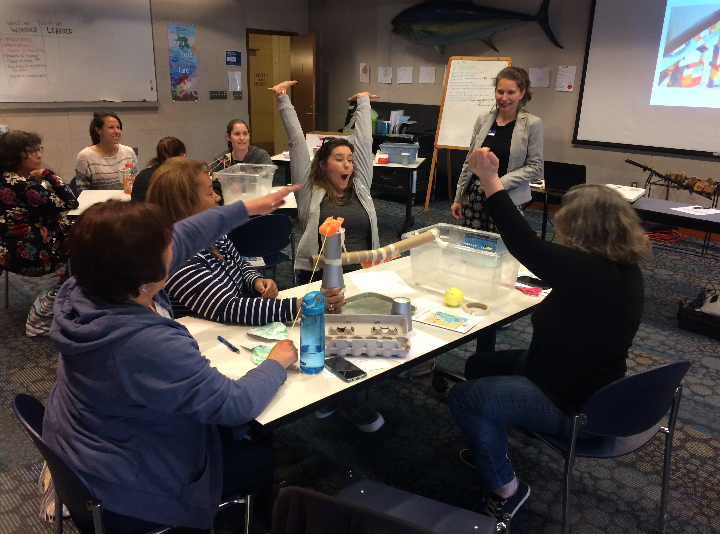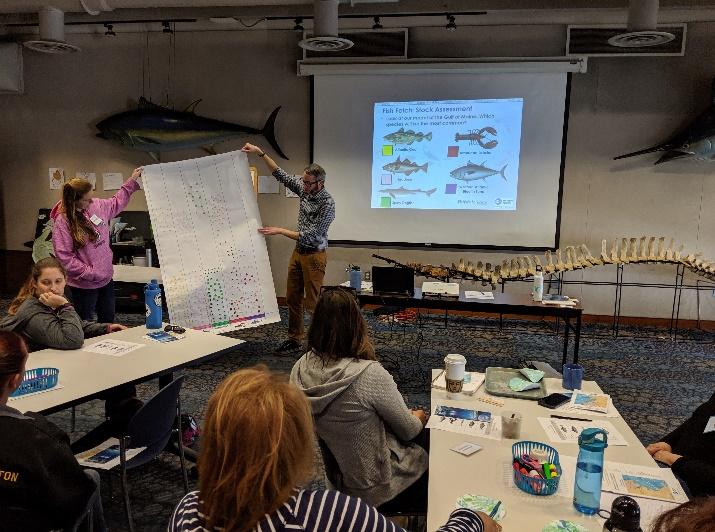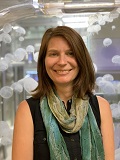Next Gen Navigator
Helping Educators Develop Young Ocean Problem-Solvers
By Corrine Steever
Posted on 2019-10-17

Informal science centers are in perfect alignment to provide rich NGSS supports using three-dimensional learning and real-world connections. When an educator hears about professional development opportunities at the New England Aquarium (NEAq), they are typically “hooked” by the idea that they may get some great lessons about ocean animals for the classroom while gazing at Myrtle, our 550 lb. green sea turtle. While the “hook” might be Myrtle, the “reel” is linking rich, real-world, accessible phenomena at the NEAq with NGSS-supported lessons for the classroom. Informal science centers like NEAq create models and analyze real-world phenomena using exhibits and research, and are a perfect resource when introducing phenomena in the classroom. NEAq is also a conservation-oriented organization, and our goal is to establish connections to nature, strengthen relationships, develop systems thinking, build skills for civic participation, provide diversity of participation and access, and promote hope, self-efficacy, and confidence. That is why we work to increase the capacity of educators, both in and out of the classroom, using the ocean as a means of providing three-dimensional learning opportunities that align with our goals.
To do this, we restructured how we run our professional development courses to start with a deep exploration of the standards that our courses will support, and then modeling what a lesson or activity could look like. By working with educators to focus on the content and practices of a standard, it helps define what the students will be learning, as well as how they will be learning. The Next Generation Science Standards does this. The NSTA website displays the standards in a way that lets you highlight the Practices, Disciplinary Core Ideas, and Crosscutting Concepts that go with each performance expectation. Using highlighters and printouts of standards, educators in small groups work through this themselves. This allows for great discussions on how they would have students engage in experiences that support the standard(s) we are working on. Where the real supports lie, though, is then modeling what this could look like in a series of activities built on real-world experiences that support why students should be learning these concepts.
An example of this is in our Full STEAM Ahead: Ocean Adventures workshop series for early educators. During the Ocean and Us class, our goal was to introduce lessons that support the following K–2 Performance Expectations:
Performance Expectations |
|
K-ESS2-1 |
Construct an argument supported by evidence for how plants and animals (including humans) can change the environment to meet their needs. |
K-ESS3-1 |
Use a model to represent the relationship between the needs of different plants and animals (including humans) and the places they live. |
K-ESS3-3 |
Communicate solutions that will reduce the impact of humans on the land, water, air, and/or other living things in the local environment. |
K-LS1-1 |
Use observations to describe patterns of what plants and animals (including humans) need to survive. |
1-LS1-1 |
Use materials to design a solution to a human problem by mimicking how plants and/or animals use their external parts to help them survive, grow, and meet their needs. |
K-2-ETS1-1 |
Ask questions, make observations, and gather information about a situation people want to change to define a simple problem that can be solved through the development of a new or improved object or tool. |
K-2-ETS1-3 |
Analyze data from tests of two objects designed to solve the same problem to compare the strengths and weaknesses of how each performs. |
We started the day with an icebreaker about systems. Since systems is a Crosscutting Concept that is within many of the standards addressed, we wanted to begin by building a deeper understanding of biological systems. Small groups were given an image of the same tide pool ecosystem inspired by Istvan Banyai’s picture book Zoom. Some groups had a very “zoomed-in” version of the tide pool (such as a tide pool animal), while others had a very “zoomed-out” coastline view. Everyone else observed images at a scale in between those two versions. Each group defined the boundary of their image, then discussed the “living components” of the organisms in the pictures, what they needed to survive (food, water, shelter), and what was flowing in and out of the system (sun, water, air, food). Each shared their image and what they came up with. This allowed for the “aha” moment when the educators noticed that all their pictures were just “zoomed in or out” versions of one another, allowing for not only an understanding of how individuals fit into a large system, but also how the larger system impacts individuals.
Then throughout the day, we built lessons from a systems framework, using an image of a New England river with a dam and an arrow pointing farther up the river, and the prompt “Salmon swim upriver to spawn here.” After allowing educators to share their observations and questions, we created many of the lessons around this phenomenon, while answering most of the questions that the group came up with through engaging in activities. While at NEAq, we visit the salmon exhibit to observe how salmon swim and move, but we also show that for those without access to a facility like NEAq, such investigations can be done using videos and books, and by making models of fish with potatoes and different fin shapes using craft materials.
When modeling and seeking to understand systems, we know that it is important to understand human impact on systems, and we can draw on our knowledge to train educators on how to communicate using values and solutions. Teachers develop an understanding that we use rivers, just like other plants and animals do, but sometimes our actions can have unintended consequences. Teachers learn how humans have built fish ladders to aid movement of fish past dams, then engage in engineering activities to build models of fish ladders, eventually doing this with learners to help them increase their hope and self-efficacy. It also boosts educators’ confidence to teach even their youngest learners about their connection to the natural world.


We live on a blue planet, and know it is important to inspire problem-solvers to act on behalf of the ocean. This is just one example of the many ways that we are trying to support educators at the New England Aquarium to develop ocean problem-solvers through three-dimensional learning opportunities.
What are some ways you are using real-world phenomena to engage in three-dimensional learning experiences? Are you able to use an informal science center near you, or are you working at an informal science center that provides opportunities for educators?
 Corrine Steever is the Teacher Services Supervisor at the New England Aquarium in Boston, Massachusetts. She provides teacher professional development programs that enhance participants’ understanding of ocean science, and cross-curricular connections that support multiple ways to engage their students in STEM practices. The New England Aquarium also provides free resources to educators through their Teacher Resource Center. Steever is a board member of the Massachusetts Association of Science Teachers and Massachusetts Marine Educators.
Corrine Steever is the Teacher Services Supervisor at the New England Aquarium in Boston, Massachusetts. She provides teacher professional development programs that enhance participants’ understanding of ocean science, and cross-curricular connections that support multiple ways to engage their students in STEM practices. The New England Aquarium also provides free resources to educators through their Teacher Resource Center. Steever is a board member of the Massachusetts Association of Science Teachers and Massachusetts Marine Educators.
Note: This article is featured in the October 2019 issue of Next Gen Navigator, a monthly e-newsletter from NSTA delivering information, insights, resources, and professional learning opportunities for science educators by science educators on the Next Generation Science Standards and three-dimensional instruction. Click here to sign up to receive the Navigator every month.
The mission of NSTA is to promote excellence and innovation in science teaching and learning for all.
Disclaimer: The views expressed in this blog post are those of the author(s) and do not necessarily reflect the official position of the National Science Teaching Association (NSTA).
Phenomena Three-Dimensional Learning Informal Education


